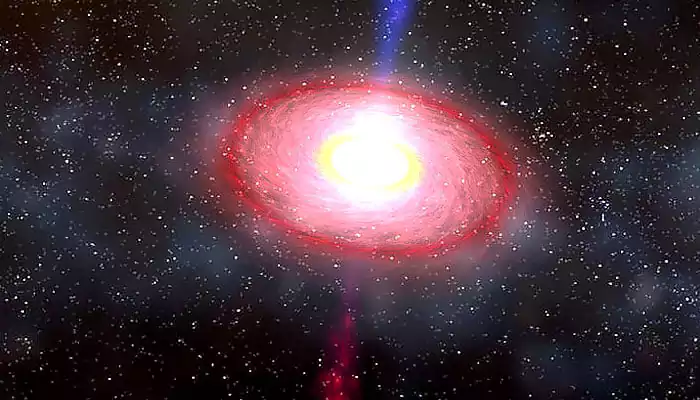Astronomers have spotted an immensely energetic explosion emanating from an ancient galaxy, appar-ently triggered by a type of star destruction hy-pothesised for decades but never before observed. You might call it stellar death by demolition derby.
Researchers said the gamma-ray burst they ob-served may have been caused by the collision of two compact stars in the densely packed and chaotic envi-ronment near a supermassive black hole at the centre of this elliptically shaped galaxy. They suspect the two doomed stars were neutron stars, which pack roughly the mass of our sun into a sphere only the size of a city.
“In order to explain the gamma-ray burst, it has to have been a compact star, so not one like the sun,” said astronomer Andrew Levan of Radboud Univer-sity in the Netherlands, lead author of the research published this week in the journal Nature Astron-omy. “Gamma-ray bursts are the most powerful ex-plosions in the universe. They release more energy per unit time than any other known cosmic phenom-ena. So they are really superlative in their properties. Their name comes from the first type of light that we see, gamma-rays, but they actually emit across the electromagnetic spectrum,” said astrophysicist and study co-author Wen-fai Fong of Northwestern University in Illinois.
Immense gravitational forces exerted by the black hole at the galactic centre may wreak havoc, per-turbing the motion of nearby stars and other objects and increasing the chances of collisions — akin, the researchers said, to a demolition derby.
“Most stars in the universe die in a predictable way, which is just based on their mass,” Levan said. “This research shows a new route to stellar destruc-tion.” Very massive stars — more than 10 times the sun’s mass – die in a supernova blast that leaves behind neutron stars or even denser black holes, whose gravitational pull is so strong no matter or light can escape. Relatively low-mass stars like our sun puff up and blow off their outer layers, trans-forming into a stellar remnant called a white dwarf.
The new findings show another path to stellar demise. “The idea that stars also can die through collisions in extremely dense regions has been around since at least the 1980s. So we’ve been wait-ing for 40 years for the signatures to be found ob-servationally,” Levan said.
The researchers used data from orbiting and ground-based telescopes to study the gamma-ray burst in a galaxy about 3 billion light-years away from Earth, roughly in the direction of the constella-tion Aquarius. A light year is the distance light trav-els in a year, 9.5 trillion km.
This ancient galaxy was populated primarily by stars several billion years old. “The galaxy is what we call ‘quiescent’ — a galaxy that is not actively forming stars at a high rate and is past its heyday,” Fong said. —APP










